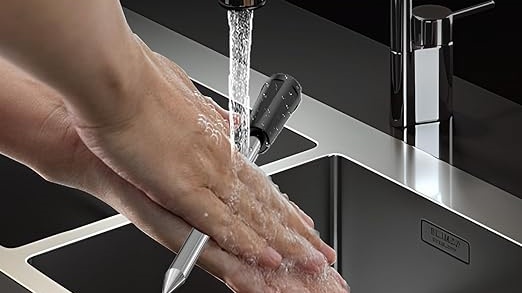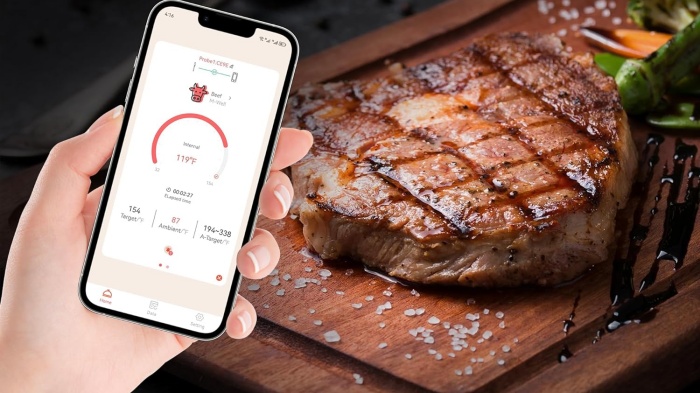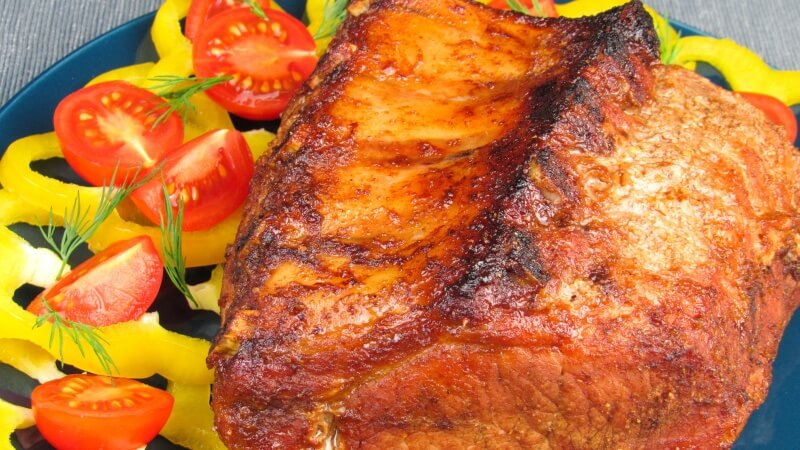
How To Enhance Your DIY Meat Probe with Voice Control Features
Every culinary enthusiast knows the importance of a perfectly cooked steak, and that’s where a meat probe comes in handy. But what if we could

When it comes to cooking perfection, a meat probe is an indispensable tool for any chef or home cook.
But in the world of meat probe, there’s a new debate: wearable versus wireless. Which reigns supreme in the kitchen?
In the blue corner, we have wearable meat probes, clinging to your meat like a culinary champion, and in the red corner, the wireless meat probes, offering freedom and flexibility. Both contenders promise precision, but how they deliver this is what sets them apart. Let’s take a closer look at each of these kitchen gadgets to understand their strengths and weaknesses better.
Wearable meat probes are the new kids on the block, boasting a design that allows them to be attached directly to the meat. This direct contact ensures accurate and consistent readings.
They are especially useful for long cooking processes, where constant temperature monitoring is crucial. But their reliance on physical attachment might pose a challenge in certain cooking scenarios.
For example, if you’re grilling multiple steaks of varying thicknesses, using a wearable probe on each piece might not be feasible.
Furthermore, the direct attachment means they are exposed to intense heat for prolonged periods, which could affect their longevity and reliability over time.
Despite these limitations, the precision and real-time feedback provided by wearable meat probes make them a valuable tool for cooking meats to perfection.
They’re particularly favored in professional settings where consistency and precision are paramount. The construction of these probes is typically robust, designed to withstand the harsh environment of commercial kitchens, making them a durable choice. However, their higher cost compared to traditional probes can be a consideration for home cooks.
Wireless meat probes stand out with their convenience. Free from wires, they offer the flexibility to move around the kitchen or even step away without losing track of your cooking progress. They connect to smartphones or digital displays, providing real-time updates.
However, this wireless technology might come with concerns over connectivity and battery life. In situations where Wi-Fi or Bluetooth connectivity is weak or interrupted, the reliability of these probes can be compromised.

Additionally, the need to regularly charge or replace batteries can be a nuisance, especially if you find yourself with a dead probe mid-cooking.
Despite these potential drawbacks, the appeal of wireless probes lies in their ability to integrate with modern smart kitchen setups, offering enhanced features like cooking alerts and temperature history tracking.
For the tech-savvy cook, these features are a significant advantage, providing insights and data that can improve cooking over time. The flexibility of not being tethered to the meat allows for monitoring multiple dishes simultaneously, a boon for busy cooks preparing complex meals.
However, the accuracy of wireless probes can sometimes be slightly less reliable than wearable ones, as factors like distance and obstacles between the probe and receiver can affect readings.
Both wearable and wireless meat probes have unique features that cater to different cooking needs. By delving into their advantages and limitations, we can better understand which tool might be the best fit for our culinary adventures.
Wearable meat probes shine in their ability to provide continuous and immediate temperature readings. This is particularly advantageous when cooking meats that require precise temperature control, such as a medium-rare steak or a tender brisket.
Their durability and resistance to various cooking environments make them a reliable choice for both professional chefs and home cooks. The direct attachment to the meat minimizes the chances of misplacement or accidental damage, common issues with more portable probes.
For chefs who value consistency and want real-time data without any delays, wearable meat probes are invaluable. They also tend to be more resistant to interference from other kitchen appliances, providing a more stable and reliable reading throughout the cooking process.
Wearable probes are particularly beneficial for recipes that require exact temperatures, such as sous-vide cooking, where even a few degrees can make a significant difference. Their robust design often includes features like waterproof and heat-resistant materials, making them a long-lasting investment.
However, their higher cost compared to traditional probes and the requirement for physical attachment to the meat can limit their versatility and appeal to a broader audience. Additionally, their use might require more technical understanding, which could be a hurdle for less tech-savvy cooks.
Despite their precision, wearable meat probes can be somewhat limited in versatility. Being physically attached to the meat, they are not ideal for quick checks or for use with multiple dishes at once.
Additionally, their design might not be as user-friendly for novice cooks who prefer a more straightforward approach. The physical connection to the meat also means that they can be difficult to clean, as they need to withstand high temperatures and potential contamination from raw meat.
Moreover, in complex cooking environments where multiple items need monitoring, the single-point focus of a wearable probe might not suffice.
The requirement for physical attachment can be cumbersome in scenarios like grilling or smoking, where the cook might need to frequently adjust or move the meat. The bulkier design of some wearable probes can also interfere with the cooking process, especially in tightly packed cooking environments like ovens or smokers.
While the durability of these probes is a significant advantage, it often comes at a higher cost, which might not be justifiable for casual cooks or those who don’t require such high precision in their cooking.
The standout feature of wireless meat probes is their convenience. The ability to monitor your cooking remotely means you can entertain guests or manage other kitchen tasks without being tethered to the oven. This freedom is a game-changer, particularly for those who multitask or cook large meals.
Moreover, wireless meat probes often come with smart features, like app integration, which offers not just temperature readings but also cooking tips and alerts. These features are particularly beneficial for those new to cooking or those who enjoy experimenting with different recipes and techniques.
The added bonus of being able to track and record your cooking data over time helps in refining your cooking skills and achieving consistent results. The wireless design also means these probes are generally more compact and easier to store, an important consideration in smaller kitchens.

For modern kitchens equipped with smart devices, wireless probes integrate seamlessly, enhancing the overall cooking experience with their advanced features.
The ability to monitor multiple dishes simultaneously through app integration is a significant advantage for cooks preparing complex meals or hosting large gatherings.
The main drawbacks of wireless meat probes revolve around their dependency on technology. Issues like battery life, connectivity range, and potential interference can pose challenges. Furthermore, while the smart features are helpful, they can sometimes overcomplicate what should be a simple process, potentially deterring those who prefer traditional cooking methods.
The reliance on external devices like smartphones or tablets can also be a downside, as it requires the user to have these devices on hand and charged. In situations where technology fails, such as a dead battery or a lost connection, the wireless probe becomes virtually useless, leaving the cook without any means to accurately gauge the temperature of their dish.
Moreover, the accuracy of readings from wireless probes can vary based on factors like distance, obstacles, and the quality of the wireless signal. This variability can be a concern for dishes that require precise temperature control.
The user interface of the associated apps can also vary significantly, with some being user-friendly and intuitive, while others may be complex or glitchy. For those not comfortable with navigating digital apps, this could be a significant drawback.
Additionally, the initial setup and pairing process with smart devices can be a hurdle for less tech-savvy users. The cost of wireless meat probes can also be a consideration, as advanced models with extensive features may come with a higher price tag.
While they offer convenience and advanced features, balancing these with reliability and simplicity is crucial for users to get the most out of their wireless meat probe.

In the battle between wearable and wireless meat probe, there is no clear winner. Each type has its unique strengths that cater to different cooking styles and preferences.
If precision and consistency are your top priorities, a wearable meat probe is your ideal kitchen companion.
However, if convenience and flexibility are what you seek, a wireless meat probe will serve you well.
Ultimately, the choice depends on your individual cooking needs and what aspects of the cooking process you value the most. Happy cooking, and may your meat probe guide you to culinary excellence!


Every culinary enthusiast knows the importance of a perfectly cooked steak, and that’s where a meat probe comes in handy. But what if we could

The moment you bring a meat probe into your kitchen, it’s not just about cooking anymore; it’s about precision, about transforming an ordinary meal into

Ever questioned if a meat probe could be your secret weapon for the perfect roast chicken? It’s a culinary showdown: the precision of a meat

Creating a meater probe isn’t just about technical prowess; it’s also an opportunity to express your style and creativity. A well-designed probe not only functions

Every culinary enthusiast knows the importance of a perfectly cooked steak, and that’s where a meat probe comes in handy. But what if we could

When it comes to cooking perfection, a meat probe is an indispensable tool for any chef or home cook. But in the world of meat

The moment you bring a meat probe into your kitchen, it’s not just about cooking anymore; it’s about precision, about transforming an ordinary meal into

Ever questioned if a meat probe could be your secret weapon for the perfect roast chicken? It’s a culinary showdown: the precision of a meat
Copyright © 2024 meaterprobe. All Rights Reserved.